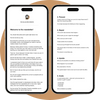Maximalism is an emerging trend in graphic design that embraces complexity, vibrant colors, and intricate patterns.
Maximalist graphic design is a reaction against the popular minimalist aesthetic of recent decades.
Designers are now seeking to fill spaces with ornate decoration and sensory details.
By embracing "more is more," maximalism offers an exciting alternative approach for graphic design.
Characteristics of Maximalist Graphic Design
Maximalist graphic design is defined by certain qualities that set it apart from other aesthetics. Key characteristics include:
- Vibrant, saturated color palettes with bold, contrasting hues that often clash. Maximalist designers use a wide diversity of colors rather than muted, analogous palettes.
- Complex and dense compositions with many elements layered and interwoven. Maximalist layouts reject simplicity and empty space in favor of crowded, abundant arrangements.
- Intricate, decorative patterns and textures like floral motifs, animal prints, paisleys, and geometrics. These ornate patterns provide visual interest.
- Typography with multiple fonts, scales, weights, and effects like gradients and shadows. Maximalist type embraces diversity over consistency.
- Asymmetries and intentionally "clashing" visual styles. Grid systems and alignment are ignored in favor of random, collage-like layouts.
- Retro and vintage inspired motifs and ornaments from Art Deco, Baroque, and other past eras. These nostalgic elements have been revived.
- Rejection of minimalism in favor of eclectic, ornamental abundance. Negative space and clutter reduction are avoided.
Principles of Maximalist Design
These principles exemplify the maximalist philosophy and guide designers working in this aesthetic:
- More is more - embrace complexity and abundance. Reject minimalism and simplicity. Layer textures, colors, shapes, and content.
- Decoration over minimalism - intricate floral patterns, geometric shapes, and vintage ornaments are essential to create dense, decorative compositions.
- Contrast and diversity - clashing, discordant colors and fonts create appealing tension. Mix and match diverse styles.
- Sensory intensity - optically stimulating, electrifying designs energize viewers. Vibrant palettes and jarring juxtapositions catch attention.
- Nostalgia and retro styles - tap into nostalgia by reviving ornate vintage motifs from past eras like Baroque, Art Deco, and Memphis style.
Tips for Creating Maximalist Designs
Here are some useful tips for designers looking to apply maximalist principles in their visual content and layouts:
- Use a vibrant, diverse color palette - don't be afraid to clash highly saturated, contrasting hues. Maximalism celebrates color.
- Layer many textures, shapes, illustrations and graphic elements. Overlap and weave visuals to create dense arrangements.
- Break grid systems and embrace asymmetric or random compositions. Scatter elements for an energetic, freeform look.
- Combine multiple fonts, scales, weights, and styles. Mix script, display, and vintage fonts for typographic diversity.
- Add ornate decorative elements like floral patterns, geometric shapes, borders, and distressed textures. Seek inspiration from past ornamental styles.
- Draw inspiration from Baroque, Rococo, Victorian, and Memphis style. Study their indulgent approaches to decoration and revival.
- Look to vintage motifs from the 1920s, 50s, 60s, and 70s. Art Deco, midcentury kitsch, and retro pop art offer striking graphics.
The Takeaway
By embracing maximalist principles of:
- Abundance
- Diversity
- Decoration
Graphic designers can create bold, nostalgic, and lively visual content that captures attention.
The maximalist celebration of "more is more" opens new creative possibilities.

